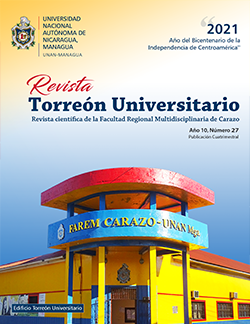Escorrentía superficial y acciones participativas para la gestión ambiental en la Subcuenca III de la Cuenca Sur del Lago de Managua, Nicaragua
DOI:
https://doi.org/10.5377/torreon.v10i27.10844Palabras clave:
Número de Curva, coberturas de la tierra, Unidades de Respuesta Hidrológica, sector público y privadoResumen
En la Subcuenca III de la Cuenca Sur del Lago de Managua, Nicaragua, existe un aumento de la escorrentía superficial causada por el incremento de las coberturas urbano, agricultura, y por la tendencia fluctuante de la cobertura bosque. En este estudio se evaluó la escorrentía superficial en función de las coberturas de la tierra de los años 2003, 2010, 2016, y el año proyectado 2025. Metodológicamente se delimitó el área en estudio en 23 Unidades de Respuesta Hidrológica (URH) con el fin de identificar las áreas donde se producen los mayores escurrimientos. En cada URH se aplicó el método Número de Curva (CN) del Servicio de Conservación Suelos (SCS), y para discretizar el método se utilizó un hietograma, el tipo hidrológico de suelo y la condición de humedad antecedente. El hietograma se generó con base en el calculo de las Curvas de Intensidad, Duración, Frecuenca. Además, el número hidrologico se estimó con base en el tipo de suelo y la elaboración de los mapas de coberturas de la tierra para cada año evaluado. Los resultados indican que las URH asociadas a las coberturas agricultura y urbano se generan los mayores escurrimientos (47 m3.s-1, 36 m3.s-1, 25 m3.s-1, 13 m3.s-1, y 10 m3.s-1). Por lo tanto, en estas URH es recomendable la implementación de acciones participativas de índole regulatorio, económico, educativa, y organizacional para la gestión ambiental del área en estudio.
Descargas
Descargas
Publicado
Número
Sección
Licencia
The authors who publish in this journal agree to the following terms.
- The author or authors of the articles, essays or research grant the National Autonomous University of Nicaragua, Managua (UNAN-Managua) the editing rights (copyright) of the submitted work, therefore the University has the exclusive right to publish the article for the entire copyright period.
- These copyrights/authors authorize Torreón Universitario Magazine and the University to edit and disseminate/publish the article in said Magazine, including printed and electronic reproduction, storage, retrieval and any other type of publication, and sources of secondary information as services. of summaries and databases, they also empower it to protect the article against unauthorized use for dissemination by printed or electronic media (PDF, HTML, EPUB, XML or others).
License for use of content
The magazine uses the Creative Commons Attribution-NonCommercial-NoDerivs 4.0 International License.
Under this statement:

This journal is licensed under a Creative Commons Attribution-NonCommercial-NoDerivatives 4.0 International License. It can be copied, distributed and transmitted publicly as long as the author and source are cited (Revista Torreón Universitario), it should not be modified or used for any commercial purpose. The full license can be found at http://creativecommons.org/licenses/by-nc-nd/4.0/.



